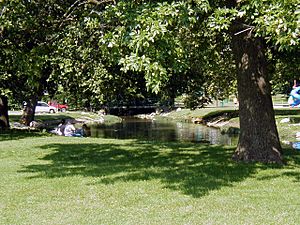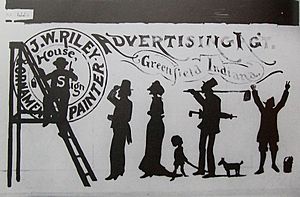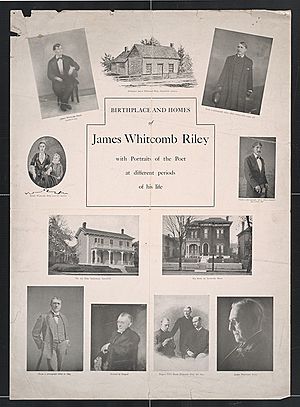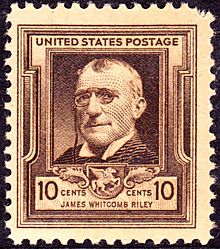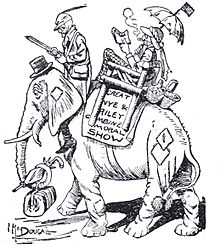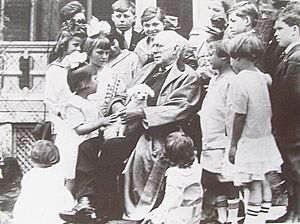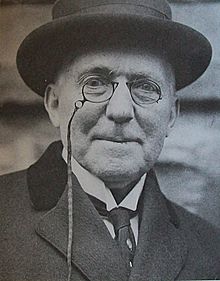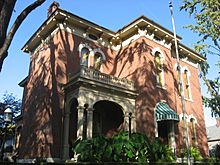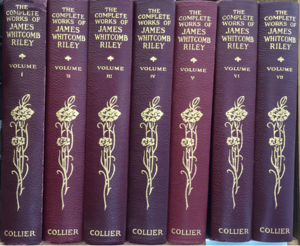James Whitcomb Riley facts for kids
Quick facts for kids
James Whitcomb Riley
|
|
|---|---|
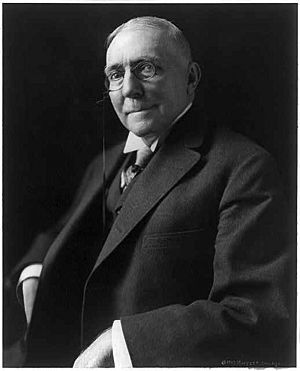
James Whitcomb Riley, c. 1913
|
|
| Born | October 7, 1849 Greenfield, Indiana, United States |
| Died | July 22, 1916 (aged 66) Indianapolis, Indiana, United States |
| Resting place | Crown Hill Cemetery |
| Pen name | Benjamin F. Johnson of Boone Jay Whit Uncle Sidney |
James Whitcomb Riley (born October 7, 1849 – died July 22, 1916) was a famous American writer and poet. During his life, people called him the "Hoosier Poet" and the "Children's Poet." He was known for his poems that used everyday language and for his fun poems for kids.
Riley started his career by writing poems for newspapers and as a sign painter. With help from famous poet Henry Wadsworth Longfellow, he got jobs at Indiana newspapers in the late 1870s. He became well-known in the 1880s by going on poetry reading tours. He traveled across the Midwest and then all over the country.
By the 1890s, Riley was a best-selling author. His children's poems were put into a book called Rhymes of Childhood. This book was very popular and sold millions of copies. Riley became very famous during his lifetime. People celebrated "Riley Day" across the United States. He often performed at big national events. He kept writing and doing readings until a stroke affected his right arm in 1910.
Riley's main impact was helping to create a special cultural identity for the Midwest. He also contributed to the Golden Age of Indiana Literature. He worked with other writers to create a unique style of writing from the Midwest. Many places are named after Riley, including the James Whitcomb Riley Hospital for Children.
Contents
Early Life and Childhood
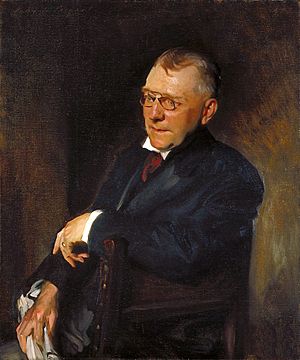
Family and Growing Up
James Whitcomb Riley was born on October 7, 1849, in Greenfield, Indiana. He was the third of six children. His father, Reuben Andrew Riley, was a lawyer. He was also a member of the Indiana House of Representatives. Riley's father named him after James Whitcomb, who was the governor of Indiana. Riley's uncle, Martin Riley, also wrote poems for local newspapers. Riley loved his uncle, who helped him become interested in poetry.
Soon after James was born, his family moved to a bigger house. James was a quiet boy who liked to watch and think. His mother taught him to read and write at home. He started school in 1852 but found it hard and often got into trouble. He liked his last teacher, Lee O. Harris, who saw Riley's love for poetry and encouraged him.
Riley didn't go to school all the time. He finished eighth grade when he was 20 years old in 1869. He later said he didn't know much about math or science. Some people thought his simple education helped him. His poems were written in the language of everyday people, which made them very popular.
Childhood Fun and Inspiration
Riley lived at his parents' home until he was 21. When he was five, he started spending time at Brandywine Creek. His poems "A Barefoot Boy" and "The Old Swimmin' Hole" are about his time there. Many people he met as a child later inspired his poems. His father often brought home people who needed help. Riley's poem "The Raggedy Man" is based on a German traveler his father hired. Riley learned the way people spoke in central Indiana from travelers. This influenced hundreds of his poems written in 19th-century Hoosier language.
His mother told him stories about fairies, trolls, and giants. She also read him children's poems. She was very superstitious, and this influenced many of Riley's works. This can be seen in his poem "Flying Islands of the Night."
Riley and his friends didn't have many toys. They made their own fun. With his mother's help, Riley started creating plays. He and his friends would perform them in the back of a local grocery store. As they got older, they called their group the Adelphians. They started performing in barns for bigger audiences. Riley wrote about these early shows in his poem "When We First Played 'Show'."
Many of Riley's poems have musical parts. He couldn't read sheet music, but his father taught him guitar. A friend taught him the violin. He played in local bands and became very good at the violin. Some of his later poems were even turned into songs.
When Riley was 10, the first library opened in his hometown. He loved books from a young age. He and his friends spent time at the library, where the librarian read stories and poems. Charles Dickens became one of Riley's favorite authors.
Riley's father joined the Union Army during the American Civil War. His mother had to take care of the family home. While his father was away, the family took in a 12-year-old orphan named Mary Alice "Allie" Smith. She was the inspiration for Riley's famous poem "Little Orphant Annie." Riley wanted to call it "Little Orphant Allie," but a printing mistake changed it.
Becoming a Poet
Riley's father came back from the war partly paralyzed. He couldn't work as a lawyer, and the family lost money. His father didn't support Riley's interest in poetry. The family had to sell their home in 1870 and move back to their farm. After his mother died in August, Riley and his father had a big disagreement. Riley felt sad about losing his childhood home. He often wrote about how the war and poverty took it from him.
Riley moved out of his family's home in November 1870. He briefly painted houses. Then he worked selling Bibles, but it didn't pay much. He returned to Greenfield in 1871 and became a sign painter. His first poems were clever advertisements for his customers.
Riley also acted in local theater shows to earn more money. In winter, when painting work was slow, he wrote poems. He sent them to his brother in Indianapolis, who offered them to the Indianapolis Mirror newspaper for free. His first poem appeared on March 30, 1872, under the name "Jay Whit." Riley wrote over 20 poems for the newspaper.
In July 1872, Riley joined a company that sold medicines. They had small traveling shows around Indiana. Riley joined as a performer, calling himself the "Painter Poet." He wrote and performed poems at the shows. After his act, he sold tonics to the audience.
In early 1874, Riley returned to Greenfield to become a full-time writer. He sent a poem to a Connecticut newspaper, the Danbury News. They accepted it and paid him, encouraging him to send more. This inspired Riley. He sent poems regularly, but the newspaper closed in 1875. He then traveled and performed with his theater group to earn money. In August 1875, he joined another traveling show, the Wizard Oil Company.
Early Career as a Writer
Newspaper Work
In late 1875, Riley started writing to the famous American poet Henry Wadsworth Longfellow. He wanted Longfellow to support his poetry career. Longfellow finally wrote back, saying he enjoyed Riley's poems and thought they showed "true poetic faculty." Riley carried this letter everywhere. He sent poems to many newspapers, showing Longfellow's praise. The Indianapolis Journal, a big newspaper in Indiana, became interested in his poems.
The Anderson Democrat newspaper offered Riley a job as a reporter in February 1877. He wrote local news and helped with printing. He also kept writing poems for the newspaper and selling them to bigger papers.
Riley wanted to prove his poems were good enough for famous eastern magazines. He wrote a poem that sounded like Edgar Allan Poe and sent it to the Kokomo Dispatch. He pretended it was a lost Poe poem. The Dispatch published it. But a newspaper employee found out it was a trick and told the Kokomo Tribune. This news hurt Riley's reputation.
After this, Riley lost his job at the Democrat. He went back to Greenfield to write poetry. He met Clara Louise Bottsford, a teacher. They both loved literature and started a long relationship.
Performing Poet
Without a steady job, Riley needed money. In January 1878, he joined a traveling lecture circuit. He gave poetry readings and earned a share of the profits. These shows were popular, and Riley quickly became known for his fun readings.
In August 1878, he spoke at an event near Indianapolis. He read a new poem, "A Childhood Home of Long Ago," about life in early Indiana. People liked it, and newspapers gave it good reviews.
Flying Islands of the Night is the only play Riley wrote. It was never performed, but it became popular in central Indiana in late 1878. This helped him get newspapers to accept his poetry again. In November 1879, he got a job as a writer for the Indianapolis Journal.
His play and newspaper work helped more people know about him. But his poetry readings made him most popular. He performed both serious and funny readings. By early 1879, he could draw large crowds. In 1894, writer Hamlin Garland said Riley's fame came from his amazing reading talent. His voice and expressions made people laugh and cry. His tour in 1880 took him to every city in Indiana.
As he became more famous, Riley worked hard to keep his image as a simple, friendly country poet. He wrote poems and newspaper articles that fit this image. He even changed his look to seem more ordinary.
By 1880, his poems were published across the country and got good reviews. But Riley was frustrated that he wasn't making much money. In the early 1880s, he wrote many poems to earn more. This hard work affected his health.
Success and National Fame
The Indianapolis Journal and Tours
Riley moved to Indianapolis in late 1879 to work for the Indianapolis Journal. It was a big newspaper with many readers. He wrote a regular column that often included poems. He met many important people and became friends with Eugene V. Debs. Riley had used the name "Jay Whit" for his poems, but in April 1881, he started using his own name.
Riley's money problems grew in 1881. He decided to join a lecture circuit again to earn money. He joined the Redpath Lyceum Bureau of Boston, a famous group of speakers. Riley did well, drawing big crowds in Chicago and Indianapolis.
Because he was so successful in the Midwest, the circuit leaders asked him to tour the East Coast. He agreed, signing a ten-year deal. In February 1882, he performed in Boston. Before his show, he visited Longfellow's home. Their meeting was a special memory for Riley. Longfellow told him to focus on poetry. Riley's performance in Boston was a hit. His poems made people laugh and were praised in the newspapers. Boston was the center of literature in the U.S. at the time. This helped famous magazines finally publish his work. The Century Magazine was the first, publishing "In Swimming-Time" in 1883.
By the end of 1882, Riley was making much more money from his performances. In 1883, he wrote his "Boone County" poems under the name "Benjamin F. Johnson of Boone." These poems were mostly in everyday language. They talked about simple country life in the early 1800s. "The Old Swimmin'-Hole" and "When the Frost Is on the Punkin'" were very popular. They reminded many readers of their own childhoods. A publisher, Merrill, Meigs & Company, asked Riley to put these poems into a book. His first book, The Old Swimmin'-Hole and 'Leven More Poems, was published in August 1883. It was so popular that it had a second printing that same year. Riley realized that poems about country life were his most popular.
The money from his book allowed Riley to work less. He wrote fewer poems, but their quality improved. He wrote his most famous poems in the mid-1880s, including "Little Orphant Annie."
In 1884, Riley toured major cities in the eastern United States again. He then put together a second book of poetry. It was called The Boss Girl, A Christmas Story and Other Sketches. This book had funny poems and short stories. It was popular in Indiana, but got mixed reviews elsewhere.
Riley was invited to join a big show in New York City with famous performers like Samuel Clemens. But his contract with the Redpath Bureau limited his chances. He felt his contract was holding him back.
Working with Other Writers
Riley started working with other writers from the Midwest to promote their work. Over a hundred writers joined a group called the Western Association of Writers in 1885. It became a social club and a group that competed with the eastern writers. Riley was disappointed it didn't do more, but he liked the meetings.
Through this group, Riley met many important writers from the Midwest, including humorist Edgar Wilson Nye. After his lecture tour in 1885, Riley teamed up with Nye for a new tour. They also wrote a book together, Nye and Riley's Railway Guide. It was a collection of funny stories and poems. Published in 1888, the book was quite successful.
In October 1887, Riley had a health issue called Bell's palsy. After recovering, he performed in New York City with Edgar Nye and Samuel Clemens. James Russell Lowell, a famous writer, introduced Riley. Lowell praised Riley's performance. The New York Sun newspaper said Riley's poetry brought both tears and laughter. A top critic, Edmund Clarence Stedman, said Riley's poems were the best he had ever heard. Because of this New York performance, Riley became well-known across the United States. Sales of his book The Boss Girl increased greatly.
Samuel Clemens, also known as Mark Twain, didn't like being outshined by Riley. He tried to avoid performing with him again.
After his tour in early 1888, Riley finished his third book, Old-Fashioned Roses. It was made for British readers and had mostly sonnets. It included some new poems like "The Days Gone By." Riley loved this book because it had his best works and was beautifully printed.
In late 1888, he finished a fourth book, Pipes o' Pan at Zekesbury. It was very popular in the U.S. It told stories and poems about a made-up town in Indiana. Critics thought his stories weren't as good as his poetry. But the public loved the book, and it was reprinted many times.
Riley was becoming very rich from his books and tours. He earned nearly $20,000 in 1888. He no longer needed his job at the Journal and left it that year. The newspaper had helped him become famous and published hundreds of his writings.
National Recognition
Politics and Last Tours
In March 1888, Riley had dinner at the White House with President Grover Cleveland. Riley performed briefly and spoke about the need to protect copyrights for writers. President Cleveland liked Riley's performance and invited him back for a private meeting. In the 1888 Presidential Election, Riley's friend Benjamin Harrison became the Republican candidate. Riley supported Harrison and helped with fundraising. After Harrison was elected, he suggested Riley be named the national poet laureate. Riley visited Harrison at the White House several times to perform.
Even though he was wealthy from his books, touring could triple his income. So, Riley decided to go back on tour in 1892. He hired people to manage his tours and money. His tours were carefully planned to release new books and visit different parts of the country. He didn't perform too often, only four times a week, and tours lasted only three months.
His 1895 tour was his last. It was advertised as his final performances, so tickets were in high demand. Riley performed for his biggest audiences ever. He often wished he could perform new material, but crowds always wanted to hear their favorite poems.
The Children's Poet
After his father died in 1894, Riley wished he had married and had children. To make up for this, he became a loving uncle. He gave many gifts to his nieces and nephews. He bought back his childhood home in 1893 and let his divorced sister, Mary, and her daughters live there. He took care of them and spent summers with them. He was much loved by his family.
Riley moved back near Indianapolis in 1893. He lived in a private home in the Lockerbie area. He became close friends with his landlords, the Nickum and Holstein families. His home became a place where local schoolchildren would visit. Riley would often recite poems and tell stories to them.
That same year, he put his most popular children's poems into a new book called Rhymes of Childhood. The book had beautiful pictures by Howard Chandler Christy. Riley also wrote some new poems for it under the name "Uncle Sydney." Rhymes of Childhood became Riley's best-selling book, selling millions of copies. It has been in print since 1912 and helped him earn the nickname "Children's Poet." Even Mark Twain said the book was "charming."
Later Life and Legacy
National Poet
By 1895, Riley was very rich, earning $1,000 a week. Even though he stopped touring, he still made some appearances. Most of his later performances were at big public events. He often spoke at Decoration Day events and read poetry at monument unveilings in Washington, D.C. Newspapers started calling him the "National Poet" and "the people's poet laureate." Riley wrote many patriotic poems for these events, like "The Soldier" and "America!".
In 1897, Riley's publishers suggested he create a series of books with all his works. With his nephew's help, Riley put together sixteen volumes, finished in 1914. It was rare for writers to have all their works collected like this during their lifetime. This showed how popular Riley was.
His works were even studied in top universities. He received honorary degrees from Yale in 1902 and the University of Pennsylvania in 1904. In 1908, he became a member of the American Academy of Arts and Letters. In 1912, they gave him a special medal for poetry.
Riley helped other poets start their careers. He discovered the talented African-American poet Paul Laurence Dunbar in 1892. Riley thought Dunbar's work was excellent and wrote letters to help him get published.
Health Challenges
In 1901, Riley's doctor said he had a nervous condition and needed a lot of rest. Riley was often ill for the rest of his life. His landlords and family helped take care of him. He spent winters in Miami, Florida, and summers with his family in Greenfield.
In March 1909, Riley had another health issue that caused partial deafness. On July 10, 1910, he had a stroke that paralyzed the right side of his body. He was very sad about not being able to write with his right hand. His family kept the news quiet for a while. By 1913, with a cane, Riley started walking again. But he couldn't write, which almost stopped him from creating new poems. George Ade helped him write his last five poems by taking down what Riley said. His publisher kept reprinting his old works, which were still very popular.
Since the mid-1880s, Riley had been the most-read poet in the nation. In 1912, he recorded readings of his popular poems for the Victor Talking Machine Company. His image became famous across the country. Many businesses used his popularity to sell their products.
In 1912, the governor of Indiana started "Riley Day" on the poet's birthday. Schools taught Riley's poems, and banquets were held in his honor. In 1915 and 1916, the celebration became national. In early 1916, Riley was filmed for a movie celebrating Indiana's 100th birthday.
Death and Lasting Impact
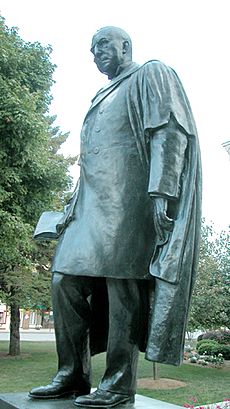
On July 22, 1916, Riley had a second stroke. He died early on July 23. Riley's death was big news across the nation. President Woodrow Wilson sent his condolences to Riley's family. Indiana Governor Samuel M. Ralston allowed Riley to lie in state at the Indiana Statehouse. Only Abraham Lincoln had received this honor before. On July 24, over 35,000 people came to see his casket. Thousands more were turned away. A private funeral was held the next day. He was buried in Crown Hill Cemetery in Indianapolis, at the highest point in the city.
Soon after Riley's death, many memorials were created. The James Whitcomb Riley Hospital for Children was built and named in his honor. Other memorials for children were also created, like Camp Riley for youth with disabilities.
The memorial foundation bought Riley's home in Indianapolis. It is now a museum called the James Whitcomb Riley Museum Home. It is the only late-Victorian home in Indiana open to the public. His birthplace and childhood home in Greenfield are also preserved as a historical site. A ship, the SS James Whitcomb Riley, was named after him in 1942.
Many schools are named after James Whitcomb Riley, including high schools and elementary schools in Indiana and Illinois. Riley Towers, an apartment complex in Indianapolis, is also named in his honor. In 1940, the U.S. Postal Service issued a 10-cent stamp honoring Riley.
Every year, the people of Greenfield hold a festival called "Riley Days" in his honor. It takes place in early October. The festival starts with a parade where schoolchildren place flowers around a statue of Riley.
Riley helped create a special cultural identity for the Midwestern United States. Before the 1880s, the Midwest didn't have a strong literary community. Riley's work, along with others, helped create this identity. Because of this, he was often called the "Hoosier Poet."
See also


